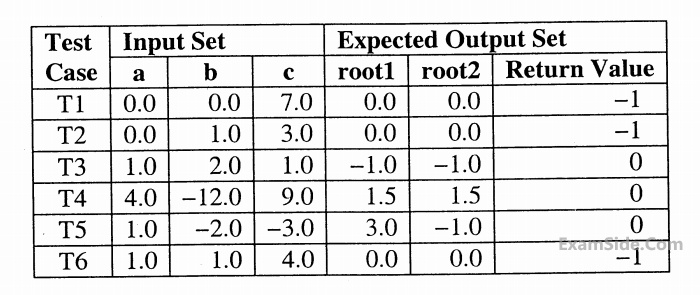$$\left\{ \, \right.$$ for (int $$i=0; i<5; i++$$)
for (int $$j=0; j<3; j++$$)
if ( $$A$$ [ $$i$$ ] $$==oldc$$ [ $$j$$ ] $$A$$ [ $$i$$ ]
$$=newc$$ [ $$j$$ ]; $$\left. \, \right\}$$
The procedure is tested with the following four test cases;
$$\eqalign{
& \left( 1 \right)\,\,\,oldc = ''abc'',\,\,newc\, = \,''dab'' \cr
& \left( 2 \right)\,\,\,oldc\, = \,''cdc'',\,\,newc\, = \,''bed'' \cr
& \left( 3 \right)\,\,\,oldc\, = \,''bca'',\,newc\, = \,''cda'' \cr
& \left( 4 \right)\,\,\,oldc\, = \,''abc'',\,newc\, = \,''bac'' \cr} $$
The tester now tests the program on all input strings of length five consisting of characters $$'a', 'b', 'c', 'd'$$ and $$'c'$$ with duplicates allowed. If the tester carries out this testing with four test cases given above, how many test cases will be able to capture the flaw?
$$\left\{ \, \right.$$ for (int $$i=0; i<5; i++$$)
for (int $$j=0; j<3; j++$$)
if ( $$A$$ [ $$i$$ ] $$==oldc$$ [ $$j$$ ] $$A$$ [ $$i$$ ]
$$=newc$$ [ $$j$$ ]; $$\left. \, \right\}$$
The procedure is tested with the following four test cases;
$$\eqalign{
& \left( 1 \right)\,\,\,oldc = ''abc'',\,\,newc\, = \,''dab'' \cr
& \left( 2 \right)\,\,\,oldc\, = \,''cdc'',\,\,newc\, = \,''bed'' \cr
& \left( 3 \right)\,\,\,oldc\, = \,''bca'',\,newc\, = \,''cda'' \cr
& \left( 4 \right)\,\,\,oldc\, = \,''abc'',\,newc\, = \,''bac'' \cr} $$
If array $$A$$ is made to hold the string $$''abcde'',$$ which of the above four test cases will be successful is exposing the flaw in this procedure?

$$i)$$ When coefficient $$a$$ is zero or irrespective of discriminate
$$ii)$$ When discriminate is positive.
$$iii)$$ When discriminate is zero
$$iv)$$ When discriminate is negative
Only in cases $$(ii)$$ & $$(iii)$$ the stored roots are valid Otherwise $$0$$ is stored in the roots the function returns $$0$$ when the roots are valid & - $$1$$ otherwise. The function also ensures root $$1$$ $$> =$$ root $$2.$$
int get QuadRoots(float a, float b, float c, float $${}^ * root1$$, float $${}^ * root2$$);
A software test engineer is assigned the job of doing block box testing. He comes up with the following test cases, many of which are redundant

Which one of the following options provide the set of non-redundant tests using equivalence class partitioning approach from input perspective for black box testing?